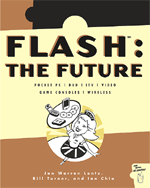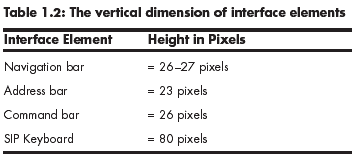| |
Authors: Jon Warren Lentz, Bill Turner, and Ian Chia
 
See it on Amazon
 Jon Warren Lentz, the lead co-author of Flash 5 Bible, has teamed up with several other authors to bring us Flash: The Future - an extensive book on developing Flash for every platform except a desktop computer. There are literally hundreds of books on Flash, but very few of them cover developing Flash for Pocket PCs, DVDs, and other obscure platforms. Flash: The Future is here to fill in this gap. Jon Warren Lentz, the lead co-author of Flash 5 Bible, has teamed up with several other authors to bring us Flash: The Future - an extensive book on developing Flash for every platform except a desktop computer. There are literally hundreds of books on Flash, but very few of them cover developing Flash for Pocket PCs, DVDs, and other obscure platforms. Flash: The Future is here to fill in this gap.
Since using Flash for these platforms is so new, there's just no manual for this stuff. Having moderated the Flash Kit message boards for over a year now, I have seen numerous questions that no one can answer:
- How much space do I really have on Pocket IE?
- How do I make stand alone applications for the Pocket PC?
- What colors do I use when developing for TV broadcast?
- What size should my Flash movie be when developing for Video or DVD?
- What frame rate should I use for a video tape?
- How do I get a Flash movie on a DVD?
- How do I get a Flash movie to auto start on a DVD?
- Etc.
But Flash: The Future answers these questions and more. Finally, people who have been down the road of developing Flash for these situations have sat down and documented their discoveries. The authors clearly lay out all of the practical solutions for developing and the pitfalls to avoid.
One thing that really impressed me about this book is that these guys are not in denial. If a solution will work for all situations except one, they don't ignore that one situation. An example of this in action is when Lentz is explaining how to get Flash to display in Pocket IE without the scrollbar. The scrollbar does take up a considerable amount of landscape when you're developing for such a small screen. Although theory suggests that designing a Flash movie at 240 X 240 pixels should prevent any scrollbars from appearing in Pocket IE, the appearance of an align tag could change that on some devices. So Lentz recommends 239 X 239 or 235 X 235 as the more ideal size.
That's experience talking.
Pocket PCs and Everything Else
The near 400 page book is broken up into two sections: Pocket PCs and Everything Else (DVDs, Video, Game Consoles, Interactive TV, and Wireless Phones). I believe that giving Pocket PCs so much attention (more than half the book) is a wise decision since there is so much more complexity to them, there are more possibilities with them, and the little things are extremely popular right now.
The authors have provided a lot of helpful tables throughout the book. The following table shows how much landscape each feature on Pocket IE takes up on a Pocket PC screen:

There are also tables that describe all the current Pocket PC models, show how long it takes to load specific sized Flash movies from a CompactFlash card, how each FScommand reacts on a Pocket PC, and much more. These tables make it very easy for the reader to find what they're looking for quickly.
When I say the rest of the book covers "Everything Else", that's what I mean. The chapters on Video cover all the different types of formats - what's available, the image quality, and the cost of the equipment needed to get your Flash in each format. It's not just an education on developing Flash for video; it's an education on video itself. This is helpful because most people, including myself, wouldn't know the first thing about the difference between Betacam SX and Betacam SP.
If you need to develop a Flash movie that's going to be a commercial on a TV station, and they say that it needs to be in Betacam SX format, do you have any idea where to start or what to charge for something like that? This book will give a good overview and point you in the right direction of how to get to work.
The rest of the book covers DVDs, mobile phones, and more.
Flashthefuture.com - Changing with the times
The biggest problem with technical books is they become outdated in a few years, sometimes shorter. With devices and Flash evolving so quickly, you have to react quickly to stay on top of the latest techniques and methods. The authors have done their best to deal with this inevitable fate by creating flashthefuture.com. This website has, so far, proved to be a great companion to the book. Latest news, bug fixes, and updates can be found there. On top of that, the authors have given out their email addresses so that readers can email them personally.
But no matter how hard the authors try, parts of the book are going to become outdated, like the chapter on Generator - Macromedia's discontinued solution for dynamic Flash content. Also, Flash Player 6 will eventually become available for portable devices giving even more possibilities for developers. Things like this are just out of the authors' hands and will mean that there should be another Flash: The Future in a few years.
I look forward to that day.
Lentz the prophet & philosopher
That brings me to the final point I want to bring up about this book - Jon Warren Lentz is a bit of a prophet and a philosopher. Quoting other Flash pioneers like Phillip Torrone and Eric Dolecki, Lentz predicts that the next big thing for Flash is wireless. He goes on to passionately challenge the readers to realize that although Pockets PCs are incredible, pinpointing how those devices have changed our lives exactly is still being determined. He says, "The answer is waiting in the future and in you, the Flash developers..." As Jon sees some new and cutting edge Flash development, he will be posting links on Flashthefuture.com.
While developing Flash for Pockets PCs, DVDs, Video, and other non-desktop mediums is still new, Flash: The Future equips its readers with the tools necessary to start exploring this uncharted territory.
Related Links:
Flashthefuture.com
Other book reviews by Scottmanning.com |
|
